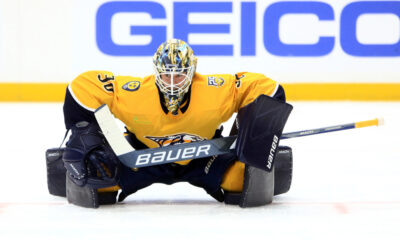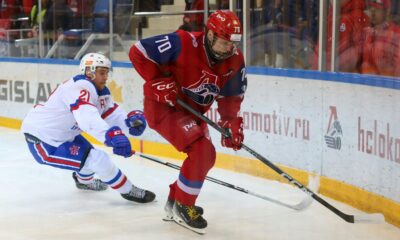Last month, Felix Nilsson recorded a secondary assist in a 4-1 victory for Rögle BK; it was his first point in 36 SHL games.
In the J20 Nationell—Sweden’s top junior league—Nilsson has dominated with five goals and 17 points in 14 contests this year, totaling 64 points in 69 career games. But despite earning 18 SHL appearances last season, Nilsson still isn’t producing at the pro level.
Taken 43rd overall by the Nashville Predators at the 2023 NHL Entry Draft, Nilsson finished atop Rögle’s J20 roster and fourth among U18 skaters in the Nationell in scoring in his draft year. In my post-draft review, I raved about the detail in Nilsson’s game, his thoroughness at both ends of the ice, and a certain fearlessness he has with the puck. Despite his lackluster box stats, which a few factors are contributing to, Nilsson is starting to show more of those positive habits in his pro appearances.
First and foremost, Rögle BK isn’t a great team. They’re 11th out of 14th in the SHL standings with a minus-nine goal differential. In terms of expected goals at five-on-five play, they’re dead even for and against despite slightly outshooting opponents per 60 minutes.
On top of that, Nilsson is barely seeing the ice with the big club; he’s 14th among team forwards in ice time, averaging just over six minutes with virtually no power-play or penalty-kill time.
Nilsson (#52, white) has been displaying good habits in transition, posting a 100% zone-exit success rate in five games tracked. He’s even gaining the offensive zone fairly well (when he’s not dumping the puck in). But more often than not, he’s forced to the perimeter and relinquishes possession as seen in the clip above. While you can see the persistence in his forecheck, Nilsson is ultimately out-muscled along the boards—an unsurprising outcome for an 18-year-old.
Nilsson (#52, green) isn’t the fastest skater, but he has good mechanics and likes to play a quick give-and-go style. In the clip above, I like how he explodes out of his neutral-zone turn with the puck. But he slows down, allowing the defense to regroup, and that forces him into being out-muscled off the puck once again instead of making a quicker pass.
Nilsson is forechecking well, and when he and his linemates have established a sustained presence in the offensive zone, he’s showing off his puckhandling skills better too. But while space against pro defenders comes at a premium, when Nilsson finds it, he doesn’t always take advantage as shown by his near-point shot above. He’s taking just 5.52 shot attempts per 60 minutes of even-strength ice time and only 1.38 of those are from high-danger areas.
Despite his struggles in generating high-danger scoring chances, Nilsson is setting up his teammates at an increasing rate. He’s using good puck-support positioning and up-ice vision to generate 13.79 primary shot assists per 60 minutes of even-strength ice time.
That shot-assist rate is a good foundation for Nilsson to build on the rest of the season. With more shifts like the one above, where he’s diving after pucks in high-danger areas and relying more on his give-and-go style in the offensive zone, more points will come.
Points exactly like his lone assist of the year, in fact. Nilsson plays the F3 role on the forecheck beautifully, targeting the opposing defenders just as his linemates are peeling off. He makes his body and stick wide, forcing a takeaway behind the net and catalyzing his team’s offensive-zone cycle. When that falters, Nilsson doesn’t let up, pursuing another takeaway before setting up another high-danger chance leading to a goal.
I don’t expect Felix Nilsson to find a major increase in ice time in the SHL this year, but that’s part of developing in a European pro league. The 2024 World Junior Championship this month should give him a boost as he has a chance to be one of Sweden’s top contributors; but back home, it’s all about focusing on the finer details in his limited shifts: efficient forechecking, above-average stickhandling, quicker play against suffocating defenders, and more high-danger pressure against opposing goalies.

















